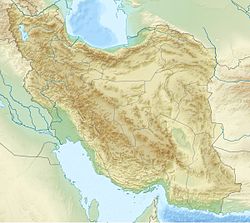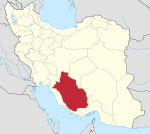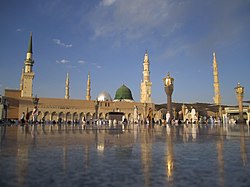Shah Cheragh
| Shah Cheragh (Shāh-é-Chérāgh) | |
|---|---|
شاه چراغ | |
 The mausoleum in 2016 | |
| Religion | |
| Affiliation | Shia (Twelver) |
| Ecclesiastical or organisational status | Mausoleum and mosque |
| Status | Active |
| Location | |
| Location | Shiraz, Fars |
| Country | Iran |
Location of the mausoleum in Iran | |
| Geographic coordinates | 29°36′34.6″N 52°32′35.9″E / 29.609611°N 52.543306°E |
| Architecture | |
| Type | Mosque architecture |
| Style | |
| Date established |
|
| Completed | Safavid era |
| Specifications | |
| Dome(s) | One (maybe more) |
| Minaret(s) | Two |
| Shrine(s) | One (Syed Amir Ahmad) |
| Materials | Plaster; stone; ceramic tiles; glass |
| Official name | Shah-e Cheragh Shrine |
| Type | Built |
| Designated | 1942 |
| Reference no. | 363 |
| Conservation organization | Cultural Heritage, Handicrafts and Tourism Organization of Iran |
| [1] | |
The Shah Cheragh (Persian: شاه چراغ, lit. 'King of Light') is a Tewlver Shi'ite funerary monument and religious complex located in Shiraz, in the province of Fars, Iran. The 12th-century complex is centred around the mausoleum of Sayyid Ahmad, the son of Musa al-Kazim, who is known as Shah Cheragh (King of Light) in local traditions, and hence the building's name.[2][3][4]
The complex was added to the Iran National Heritage List in 1942, administered by the Cultural Heritage, Handicrafts and Tourism Organization of Iran. The complex is one of the holiest sites in Twelver Shia Islam.
History
Archaeological excavation indicates that there was a settlement on the site of Shiraz in the prehistoric period and cuneiform records from Persepolis, 57 kilometres (35 mi) to the north, show that Shiraz was a significant town in Achaemenian times. As a city however, it was founded in 684 CE, after the Arab armies conquered the Sassanians. The Buyids (945-1055 CE) made Shiraz their capital, building mosques, palaces and a great city wall. The 13th and 14th centuries saw Shiraz as a literary center, especially famous for poets Sa'adi and Hafez, both of whom are buried in the city. There are many splendid Islamic monuments in Shiraz, especially its enormous Jameh Mosque of Atigh.[1]
Following the Abbasid persecution of the Shi'ite sect, Sayyid Ahmad ibn Musa (also known as Syed Amir Ahmad) and his brother, Muhammad ibn Musa al-Kazim, both of whom were brothers of Ali al-Rida, took refuge in Shiraz. Amir Ahmad died or was murdered in AH 835 (1431/1432).[1] The first structure over his grave, a simple domed mausoleum, was built in the 13th century during the rule of the Salghurids, by the minister, a former Buyid prince, attributed to Atabak Sa'ad Ebn-e-Zangi.[5]
Local folklore tells that the grave was found when a light appeared over it, which caught the attention of the people, who told the minister about what they had seen. The tombs of both brothers became celebrated pilgrimage destinations in the 14th century, during the rule of the Injuids, when Queen Tashi Khatun, the mother of Ishaq Injoo, further expanded the structure, and erected a mosque and madrasa over the tomb.[5][2]
During the Safavid era in the 16th century, the building was extensively renovated.[2] Then in the 18th century, Nader Shah donated a golden chandelier, which was hung under the dome.[4] But a few years later, an earthquake struck Shiraz, and the complex of Shah Cheragh was heavily damaged by the tremors. The golden chandelier was lost during this time. A year after the earthquake, a man named Qandeel found some remains of the donated gold, which he used to fund the reconstruction of the Shah Cheragh funerary monument.[3]
In AH 1243 (1827/1828 CE), during the reign of Fath-Ali Shah Qajar, the second ruler of the Qajar dynasty, several repairs were made to the building; including a silver zarih installed around the grave.[4] In 1958 CE, the dome was reconstructed.[1]
Architecture


The complex consists of a mosque, the mausoleum of Sayyid Ahmad ibn Musa, and, in more recent times, a history museum.[2][4]
The mausoleum of Sayyid Ahmad, made of plaster and stone, is topped by a large dome. Around the grave, a silver zarih is visible. The enormous dome above the shrine is inlaid with hundreds of thousands of pieces of finely crafted ceramic tiles and the interior walls are likewise covered with myriad pieces of dazzling cut glass intermixed with multi-colored tiles.[1] The current dome has a metal skeleton that was completed in the Qajar era. It replaced the original Safavid-era dome that was destroyed in the earthquake. Persian calligraphy lines the base of the dome.[4]
The decorative work throughout the complex is a mosaic of mirrored glass, the inscriptions are in stucco, the doors are covered with panels of silver, and the complex is enhanced by the elegant portico and the wide sahn. The tomb, with its latticed railing, is in an alcove between the space beneath the dome and the mosque. This placement is custom practice, so that it is not directly under the dome. Other pilgrimage sites in Shiraz follow similar practice. Two short minarets are situated at each end of the columned portico.[5]
Museum
The museum located within the Shah Cheragh complex was established in 1925 in a corner of the shrine.[4] In this museum, at least 600 pieces of pottery and clay artwork are stored, as well as several coins from the Parthian and Sasanian eras. Also inside the museum are weapons (such as swords) from the Safavid and Qajar eras. Several examples of manuscripts and documents are archived there as well.[4]
2022 mass shooting
On 26 October 2022, at least 15 people were killed in a mass shooting at the Shah Cheragh complex.[6] The three attackers are described by Iranian state media as apparently being takfiri terrorists. Two attackers have been arrested; the other is at large. Later the same day, Islamic State claimed responsibility for the attack.[7] The Iranian authorities said that the attackers are not Iranian nationals.[8] Iranian semi-official Tasnim news agency stated that children are among the dead.[8] The United Nations have condemned the attack on the religious site.[9]
Gallery
- The dome
- Shah Cheragh at night
- The prayer hall of the mosque in the complex
- The tomb of Mir Muhammad in the mausoleum
- The tomb of Queen Tash Khatun in the south of the complex
See also
References
- ^ a b c d e "Shah Cheragh Shrine Complex". ArchNet.org. n.d. Retrieved 22 March 2025.
- ^ a b c d چرا به امامزاده احمدبن موسی شاهچراغ در شیراز، شاه چراغ می گویند؟. beytoote.com (in Persian). Retrieved 26 November 2023.
- ^ a b حرم شاهچراغ (ع): معرفی حرم امامزاده احمد بن موسی + تاریخچه و آدرس. ایرانگرد (in Persian). Retrieved 26 November 2023.
- ^ a b c d e f g آرامگاه شاه چراغ در شهر شعر و ادب شیراز (in Persian). Archived from the original on 26 November 2023. Retrieved 5 January 2025.
- ^ a b c "Shah Cheragh Shrine". Iran Tourism and Touring Organization. 2025. Retrieved 22 March 2025.
- ^ "Fifteen killed in attack on Shia mausoleum in southern Iran". BBC News. 27 October 2022. Retrieved 27 October 2022.
- ^ "Attack on Shiraz shrine kills 15: Iranian state media". Al Jazeera. Retrieved 27 October 2022.
- ^ a b "Iran: gunmen kill at least 15 people at Shia shrine in Shiraz". The Guardian. 26 October 2022. Retrieved 27 October 2022.
- ^ "UN condemns Shiraz terrorist attack". Islamic Republic News Agency English. 26 October 2022. Retrieved 27 October 2022.
External links
- Gray, Martin. "Shiraz, Iran". Places of Peace and Power: The Sacred Site Pilgrimage of Martin Gray. Retrieved 27 July 2004.
- "Shah Cheragh" (photos). blogfa.com.
- "The Mausoleum of Shah-e-Cheragh". Shiraz City. Archived from the original on 18 May 2008.
- Video of the inside. YouTube.











